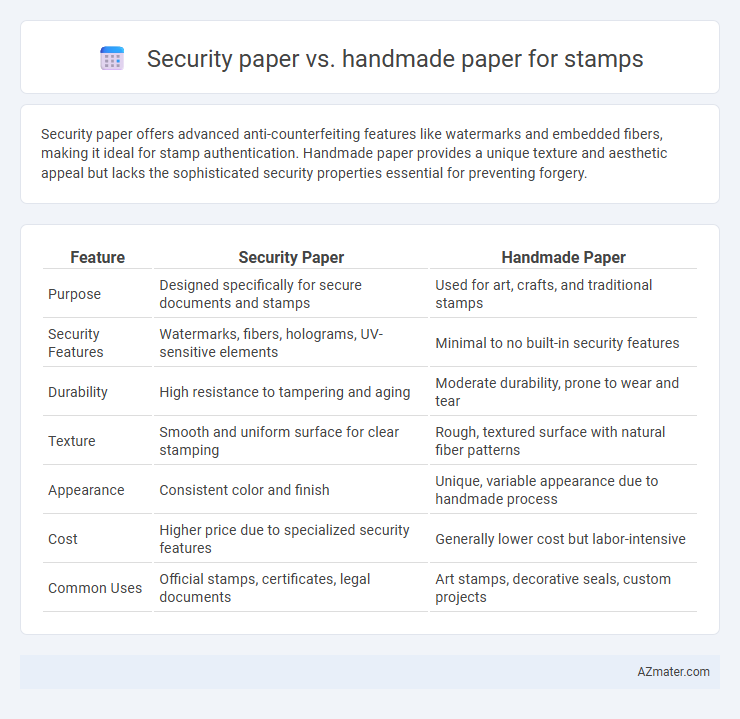Security paper offers advanced anti-counterfeiting features like watermarks and embedded fibers, making it ideal for stamp authentication. Handmade paper provides a unique texture and aesthetic appeal but lacks the sophisticated security properties essential for preventing forgery.
Table of Comparison
| Feature | Security Paper | Handmade Paper |
|---|---|---|
| Purpose | Designed specifically for secure documents and stamps | Used for art, crafts, and traditional stamps |
| Security Features | Watermarks, fibers, holograms, UV-sensitive elements | Minimal to no built-in security features |
| Durability | High resistance to tampering and aging | Moderate durability, prone to wear and tear |
| Texture | Smooth and uniform surface for clear stamping | Rough, textured surface with natural fiber patterns |
| Appearance | Consistent color and finish | Unique, variable appearance due to handmade process |
| Cost | Higher price due to specialized security features | Generally lower cost but labor-intensive |
| Common Uses | Official stamps, certificates, legal documents | Art stamps, decorative seals, custom projects |
Introduction to Security Paper and Handmade Paper
Security paper incorporates embedded features such as watermarks, security fibers, and chemical sensitizers designed to prevent counterfeiting and tampering, making it ideal for important documents like stamps. Handmade paper, crafted using traditional methods from natural fibers, offers unique texture and durability but lacks advanced security elements. Choosing security paper over handmade paper for stamps ensures enhanced protection against forgery while maintaining essential physical qualities.
Key Differences Between Security Paper and Handmade Paper
Security paper is manufactured with embedded features such as watermarks, security fibers, and chemical reactive elements to prevent forgery and counterfeiting, making it ideal for official documents and stamps. Handmade paper, created through traditional manual processes, emphasizes texture, artisanal quality, and environmental sustainability but lacks built-in security features. The key differences lie in functionality--security paper ensures document authenticity through advanced anti-counterfeit technologies, whereas handmade paper serves aesthetic and tactile purposes without specialized security attributes.
Importance of Paper Type in Philately
Security paper in philately offers enhanced protection against counterfeiting and tampering due to embedded watermarks, fibers, and chemical treatments, making it essential for preserving stamp authenticity. Handmade paper, valued for its unique texture and historic authenticity, provides collectible appeal but lacks the advanced security features critical for modern stamp verification. Choosing the appropriate paper type directly impacts the stamp's durability, provenance verification, and value in the philatelic market.
Features and Properties of Security Paper
Security paper used for stamps incorporates advanced features such as embedded watermarks, microprinting, and chemical sensitivity to prevent forgery and tampering, unlike handmade paper which lacks these specialized security elements. The fibers in security paper are designed to resist aging and environmental damage while maintaining high tensile strength, ensuring long-term durability and authentication. These properties make security paper ideal for stamps requiring anti-counterfeiting measures and reliable traceability.
Features and Properties of Handmade Paper
Handmade paper used for stamps is prized for its unique texture, durability, and natural fiber composition, which provides a tactile authenticity difficult to replicate in security paper. Unlike security paper, which incorporates embedded features like watermarks or security threads for forgery prevention, handmade paper's irregular surface and organic fibers make it highly resistant to chemical alterations and ink smudging. Its eco-friendly production process and superior archival quality ensure long-lasting preservation, enhancing the collectible value of stamps.
Security Features in Modern Stamp Paper
Security paper used for stamps incorporates advanced features such as microprinting, watermarks, and embedded fibers that prevent counterfeiting and ensure authenticity, whereas handmade paper lacks these sophisticated security elements. Modern security stamp paper often includes UV-visible threads and chemical sensitizers that react to tampering attempts, enhancing fraud detection. The integration of these security technologies makes security paper the preferred choice for official stamp production over traditional handmade paper.
Historical Usage of Handmade Paper in Stamps
Handmade paper has been historically preferred for stamps due to its unique texture and durability, making counterfeiting more difficult compared to modern security paper. Many classic stamps from the 19th and early 20th centuries were crafted on handmade paper, valued for its tactile authenticity and irregular fiber patterns. This traditional paper choice continues to hold significance among philatelists who regard it as a testament to early stamp production techniques and artisanal quality.
Durability and Preservation Comparison
Security paper used for stamps offers superior durability and tamper resistance due to embedded anti-counterfeit features such as watermarks, fibers, and chemical treatments, ensuring long-term preservation. Handmade paper, while aesthetically unique and valued for artisanal texture, generally lacks consistent strength and is more susceptible to environmental damage like humidity and light exposure. Preservation of stamps on security paper is enhanced by its resistance to fading, tearing, and forgery, making it the preferred choice for archival and philatelic purposes.
Collectors’ Perspectives: Security Paper vs Handmade Paper
Collectors often prioritize security paper for stamps due to its durability, resistance to tampering, and incorporation of counterfeit-prevention features like watermarks and embedded fibers. Handmade paper, prized for its unique textures and artisan craftsmanship, appeals to collectors seeking aesthetic and historical value despite its susceptibility to wear and environmental damage. The choice between security and handmade paper depends largely on a collector's focus on authenticity and preservation versus originality and artistic merit.
Choosing the Right Paper for Stamp Production
Security paper offers enhanced protection against counterfeiting with features like watermarks, security fibers, and chemical sensitivity, making it ideal for high-value or official stamps. Handmade paper provides a unique texture and aesthetic appeal, preferred for limited-edition or artistic stamps where authenticity and craftsmanship are emphasized. Selecting the right paper depends on the stamp's purpose: security paper for durability and fraud prevention, handmade paper for exclusivity and visual distinction.

Infographic: Security paper vs Handmade paper for Stamp
 azmater.com
azmater.com